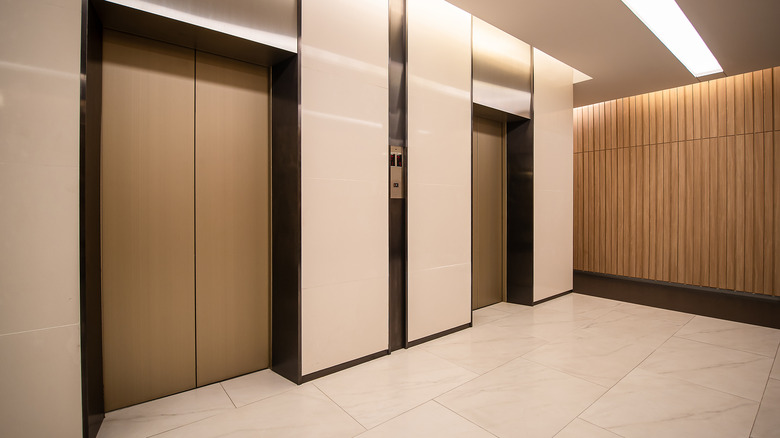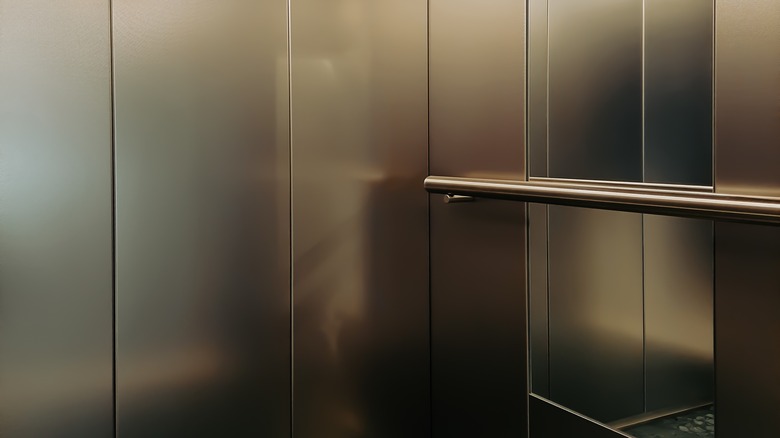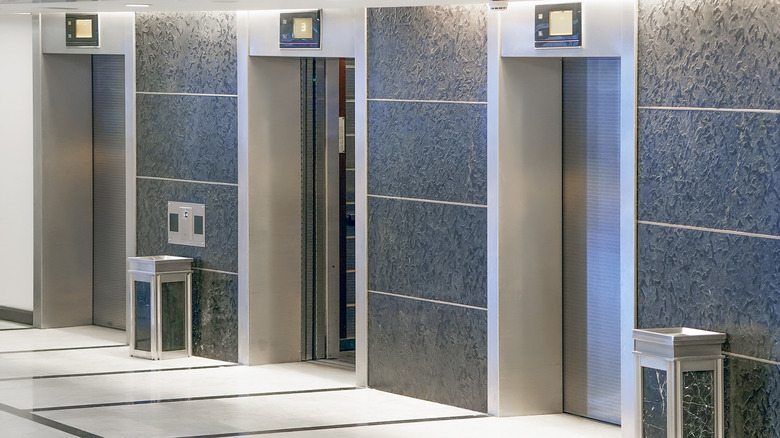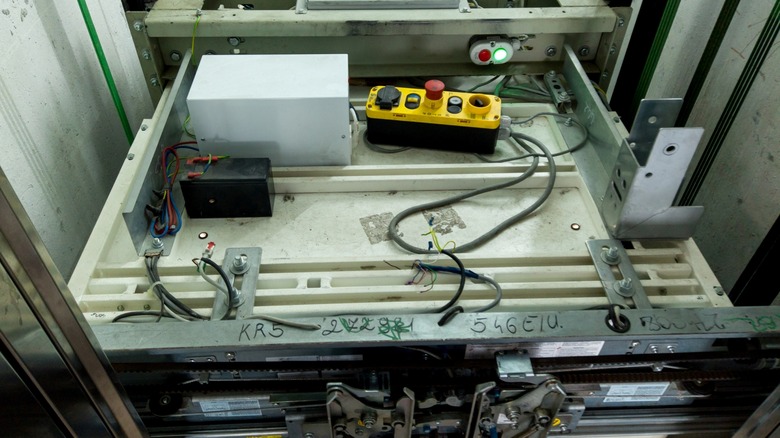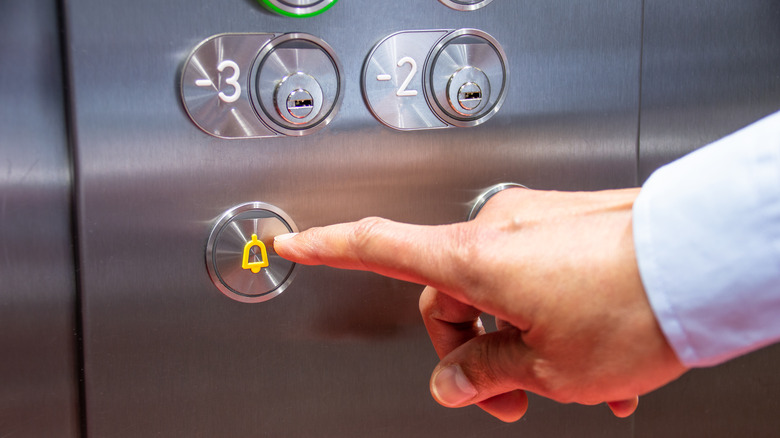Here's What To Do If You Get Trapped In An Elevator
Ever since Elisha Otis invented the first public elevator in the 1850s (per CNN), we've been using them as both a convenience (in the case of using them in favor of a short walk a couple of flights of stairs) and as a necessity (you're not getting to the top of a 90-story skyscraper without an elevator). In fact, it was Otis' introduction of a system of ratchets that stopped the machine in its literal tracks, should the cables snap, that made the elevator a thing that everyone uses without questioning it.
These days, elevator accidents are rare but not unheard of. For example, a 2006 report from the Electronic Library of Construction Occupational Safety and Health, on average about 30 Americans are injured and/or killed by elevator and escalator accidents each year.
However, falls aren't the only mishaps that can bedevil elevators and the people inside of them. Sometimes elevators simply stop working, for this reason or that, trapping people inside until they're eventually rescued. For example, in 2008, a New York City man was trapped in an elevator for 41 hours without food or water, as ABC News reported.
Getting trapped in elevators isn't as uncommon as you think
According to Elevating Studio, a well-maintained elevator in a residential or commercial building will break down (and by "break down" we mean "stop working" and not "plunge to the floor") between five and 20 times per decade. 1/4 of those breakdowns, statistically, will result in what the industry calls "mantraps" — that is, with someone inside. That means that at least once and as often as five times per decade, an elevator can be expected to fail with someone inside of it. Crunching the numbers even further, if you spend 40 years using elevators daily, for example by working or living in a building that uses them, you have a 6% chance of being trapped in an elevator at some point in your life.
Of course, that's assuming the machines are properly maintained. Poor (or absent) maintenance can cause elevators to fail more frequently than properly-maintained ones. And when it comes to elevators installed improperly, or with defective equipment, all bets are off.
You're (probably) not going to be trapped in an elevator for very long
It takes about six days to die of thirst, according to LiveScience, and several weeks to die of starvation, per Medicinenet. And while we don't seem to know for certain the longest amount of time someone spent trapped in an elevator (more on that in a moment), it certainly wasn't long enough to die of either of those causes. None of this is to say, however, that spending any amount of time trapped in an elevator, whether for hours or for days, is going to be pleasant, and of course, it's bound to be a trying experience mentally.
As for the longest anyone has been trapped in an elevator, it seems there are two answers. As mentioned previously, a New York man spent 41 hours trapped in an elevator, as ABC News reported, his ordeal worsened by the fact that he was working late and everyone in a position to help him had gone home for the weekend. That was in a public elevator in a commercial building, however. As CNN reports, a housekeeper was trapped for three days in an elevator at her employers' home. Of course, unless you are, or work for, someone wealthy enough to have an elevator in their home, you're unlikely to be trapped in such a machine.
Rule #1: Stay calm
Although doubtless easier said than done, the first rule for managing being trapped in an elevator (or for being in any stressful situation, for that matter) is to stay calm, says manufacturer Liberty Elevator. If you panic, you may find yourself unable to execute the instructions given to you by your eventual rescuer. Similarly, if there are other people in the cabin, one person panicking may cause others to panic, amplifying the problem. Further still, a room full of people hyperventilating in panic is going to get hot quickly, exacerbating things further. In fact, the manufacturer recommends that individuals trapped in elevators with other people all do their best to keep each other calm.
Also, LifeHacker provides an extra bit of reassurance: an elevator that isn't moving (or allowing the doors to open) isn't necessarily an elevator that is soon going to plunge to the ground soon. Keep this in mind while you await rescue, the website cautions.
Rule #2: Don't do anything stupid
It's basic human nature that's been baked into us through millennia of evolution: when we are trapped, the brain's first priority is getting us un-trapped. Unfortunately, in an elevator, trying to get yourself un-trapped is likely to make things considerably worse.
There are two ways out of an elevator: through the doors which, ideally, should open and close (and stay opened or closed) only when it's safe for the passengers to enter or exit; or through a maintenance door at the top, through which workers working on the machinery come and go. DO NOT try to exit through either of those exits, says LifeHacker. Few elevators have those top maintenance doors, and those that do usually keep them bolted shut. And even if you manage to get out through that door, you're just going to be stuck in the elevator shaft rather than the elevator. As for the regular exit doors, Liberty Elevator notes that if the elevator starts moving while a passenger is trying to get in or out — well, nobody wants that.
And of course, for the love of whatever deity you worship, do not try to get the elevator moving again by jumping or trying to jostle it, says LifeHacker.
Rule #3: Notify someone
There is almost certainly a cell phone in your pocket, and if you're stuck in an elevator, use it to call 911 (or your country's emergency code), says LifeHacker. Ideally, you should do this with the name and address of the building you're in, to give to the dispatcher, as well as the elevator number and floor you're stuck at (which, let's face it, might be a bit ambitious). If you don't have a cell phone or have no bars, there's probably a phone in the elevator; pick it up and you'll likely be on the phone with the elevator manufacturer, or the building superintendent. Again, having as much information as possible about your location is going to be extra helpful.
Failing those two options, the elevator probably has an alarm button on it, according to Liberty Elevator, such as the one pictured above. If you're fortunate enough to have gotten trapped in an elevator during a busy workday, if you ring it, odds are good someone will hear it.
Finally, move to the rear of the elevator. The workmen and -women who will eventually come to pry open the doors (should it come to that) will need all of the space they can get, and you don't want to be too close to potentially dangerous tools.
